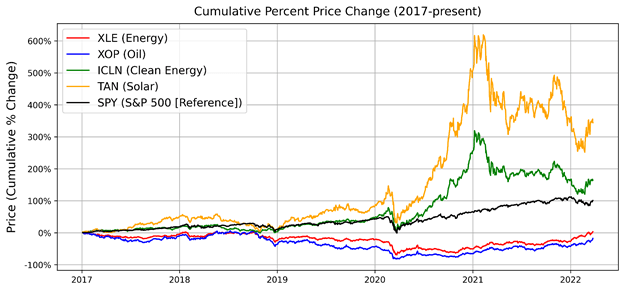The energy sector has experienced significant turbulence following the onset of the COVID pandemic. Since crude oil prices dropped below zero in April of 2020, prices have surged, exacerbated by the Russian invasion of Ukraine in February.
XOP (SPDR S&P Oil & Gas Exploration & Production ETF), a leading energy ETF, has grown by 25% since mid-February and 135% since 2021 (shown below). Similarly XLE (Energy Select Sector SPDR ETF), which is the largest energy ETF by market cap and has majority industry exposure from Oil, Gas & Consumable Fuels, has grown by 14% since mid-February and 107% since 2021.
Source: tastytrade
This past year’s energy bull run, with energy assets dramatically outperforming the overall market, has been unprecedented. However, the long-term performance of these instruments has actually been relatively stagnant. For example, XLE and XOP have grown by 3% and -18% respectively since 2017 (shown below).

Source: tastytrade
The current, volatile state of the energy sector presents an interesting opportunity for investors, particularly volatility traders. However, the sideways long-term performance of traditional energy instruments, coupled with their heavy concentration in two politicized commodities, advocates for a more diversified approach to energy exposure. There may also be longer-term uncertainty around the state of the energy market with the rising popularity of electric vehicles, increasing global computing demands and renovation of energy infrastructure among major economies. One way to gain exposure to energy while also diversifying against the oil- and gas-specific factors that significantly impact the broader energy market is clean energy stocks and ETFs.
While many clean energy assets are not yet sufficiently liquid for active retail traders, a small number have shown considerable growth in recent years. Some fairly liquid examples include Plug Power (PLUG), a hydrogen fuel cell company, and ICLN (iShares Global Clean Energy ETF), which consists of global clean energy equities. Some less liquid (but still tradable) examples include Brookfield Renewable Partners (BEP), which owns and operates renewable power assets, and TAN (Invesco Solar ETF), which consists of global solar energy companies. Compared to the ETFs concentrated in oil and gas, the clean energy ETFs, ICLN and TAN, had much stronger long-term performance since 2017, growing 164% and 344% respectively.

Source: tastytrade
In recent months, the clean energy ETFs assets have also been relatively uncorrelated with the major energy ETFs, thus offering exposure to energy and diversification against traditional energy assets.
|
3-Month Correlation (01/2022-03/2022) |
|||||
|
XLE |
XOP |
ICLN |
TAN |
SPY |
|
|
XLE |
1.00 |
0.84 |
-0.01 |
-0.01 |
-0.01 |
|
XOP |
0.84 |
1.00 |
0.20 |
0.22 |
0.22 |
|
ICLN |
-0.01 |
0.20 |
1.00 |
0.94 |
0.64 |
|
TAN |
-0.01 |
0.22 |
0.94 |
1.00 |
0.58 |
|
SPY |
-0.01 |
0.22 |
0.64 |
0.58 |
1.00 |
Source: tastytrade
Many energy assets are rich in premiums for options sellers with, for example, implied volatilities of 36% for XLE, 48% for XOP, 43% for ICLN, and 49% for TAN as of March 25 (compared to 22% for SPY). Energy assets are worth watching throughout Q2 of 2022, and supplementing traditional energy assets with clean energy assets is an effective way to achieve more diversified energy exposure.
Written by Julia Spina, Research Analyst, Finance Author, tastytrade


Be the first to comment